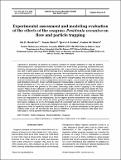Por favor, use este identificador para citar o enlazar a este item:
http://hdl.handle.net/10261/88675COMPARTIR / EXPORTAR:
 SHARE SHARE
 CORE
BASE CORE
BASE
|
|
| Visualizar otros formatos: MARC | Dublin Core | RDF | ORE | MODS | METS | DIDL | DATACITE | |

| Título: | Experimental assessment and modeling evaluation of the effects of the seagrass Posidonia oceanica on flow and particle trapping |
Autor: | Hendriks, Iris E. CSIC ORCID ; Sintes, Tomàs CSIC ORCID ; Bouma, Tjeerd J.; Duarte, Carlos M. CSIC ORCID | Fecha de publicación: | 2008 | Editor: | Inter Research | Citación: | Marine Ecology - Progress Series 356: 163-173 (2008) | Resumen: | Retention of particles in seagrass canopies is usually attributed to only the indirect, attenuating effects canopies have on flow, turbulence and wave action, promoting sedimentation and reducing resuspension within seagrass meadows. Yet recent evidence suggests that seagrasses are also able to affect particle flux directly through loss of momentum and increased path length derived from collisions with leaves and binding of particles. We evaluated the role of Posidonia oceanica on flow and associated particle trapping through flume experiments. Our results confirm the existence of 2 dynamically different environments, viz. (1) the below-canopy habitat, with low shear stress and reduced turbulence, and (2) the canopy-water interface region, characterized by high shear stress and turbulence intensity, where vertical transport of momentum is enhanced. At relatively low free stream velocities (i.e. 0.05 and 0.10 m s-1) sediment concentration decreased much faster when a Posidonia meadow was present in the flume, indicating major particle trapping in the seagrass canopy. Fluxes to the sediment (as shown by large negative peaks in Reynolds stress inside the Posidonia meadow) indicated 2 to 6 times more sediment transport to the bottom when a meadow is present. However, calculations based on the experimental results point to loss rates an order of magnitude larger in a Posidonia meadow. We hypothesize that direct effects of particle collisions with leaves are responsible for this discrepancy, and we explore possible interactions with a simple model. Using only collisions as a loss factor, the model predicts that the probability a particle is lost from the flow upon a collision is 2 to 3%. Previously observed leaf density and flow velocity effects on particle loss rates were explained by the model. Fitting the model to our experimentally obtained particle disappearance rates in vegetation indicated that around 27% of particle momentum is lost upon each collision with a leaf. We hypothesize that physical filtration by sediment collisions with plant structures plays a role in particle removal in aquatic systems. © Inter-Research 2008. | Versión del editor: | http://dx.doi.org/10.3354/meps07316 | URI: | http://hdl.handle.net/10261/88675 | DOI: | 10.3354/meps07316 | Identificadores: | doi: 10.3354/meps07316 issn: 0171-8630 |
| Aparece en las colecciones: | (IMEDEA) Artículos |
Ficheros en este ítem:
| Fichero | Descripción | Tamaño | Formato | |
|---|---|---|---|---|
| Hendriks-MEPS-2008-v356-p163-m356p163.pdf | 897,2 kB | Adobe PDF |  Visualizar/Abrir |
CORE Recommender
SCOPUSTM
Citations
209
checked on 20-abr-2024
WEB OF SCIENCETM
Citations
202
checked on 26-feb-2024
Page view(s)
431
checked on 24-abr-2024
Download(s)
312
checked on 24-abr-2024
Google ScholarTM
Check
Altmetric
Altmetric
NOTA: Los ítems de Digital.CSIC están protegidos por copyright, con todos los derechos reservados, a menos que se indique lo contrario.
